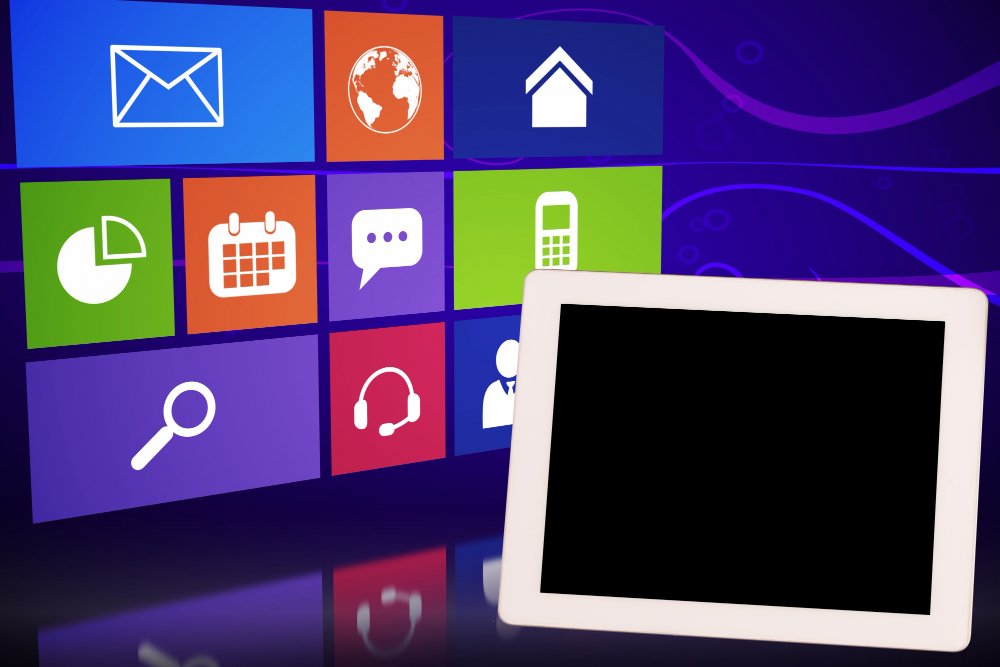
Maintaining organization and managing tasks and projects are essential in today’s digital world. Thankfully, numerous digital tools and applications are available that can assist in simplifying your planning process and enhancing productivity. These digital tools, from calendars and task managers to note-taking programs and goal trackers, provide features that improve collaboration, send reminders, and help you stay organized. This article will examine ten digital planning tools and apps that can revolutionize your method of organization and make it easier for you to accomplish your objectives.
Digital planning: What is it?
The process of creating, organizing, and managing different aspects of planning, such as personal organization, project management, task scheduling, and goal setting, using digital tools and platforms is known as digital planning. It improves and streamlines planning processes through the use of digital tools, programs, and software.
Digital Planning Components
Digital planning may include the following components:
The Top 10 Digital Planning Apps & Tools for Efficient Organization 2023
This thorough list will introduce you to strong digital planner tools to revolutionize your planning procedure and keep you organized in the modern digital age.
1. Google Calendar

Google offers a free online calendaring tool called Google Calendar. This tool allows users to create and manage events, appointments, and reminders. The purpose of Google Calendar is to aid teams and individuals in time management, schedule planning, and overall organization. Google Calendar offers a platform that is easy to use and accessible for managing schedules and events.
Users can create events with details such as title, date, time, location, and description. Users can set reminders and notifications for upcoming events to ensure they are informed beforehand. Users can also collaborate more easily, keep track of their commitments and appointments, and organize their personal and professional calendars more easily.
Features of Google Calendar:
- Management and creation of events with customizable details
- Allowing for multiple calendars will improve organization.
- Alerts and reminders for approaching events
- Features for sharing and collaborating for seamless coordination
- Utilizing other Google services to increase productivity
- Accessibility on the go with mobile apps and syncing
Advantages of Google Calendar:
- The free and open-access calendar program.
- An intuitive interface makes event creation and management simple.
- A seamless workflow is achieved through integration with other Google services.
- Features that encourage sharing and collaboration make coordination and teamwork easier
- Access to calendars is made possible on the go by mobile apps and sync.
Disadvantages of Google Calendar:
- Fewer options for customization than specialized calendar tools, use of the internet for real-time synchronization and updates
- Data stored in Google services raises privacy concerns.
- Some sophisticated features might call for a platform experience.
- Compared to specialized tools, advanced project management capabilities are lacking.
2. Notion
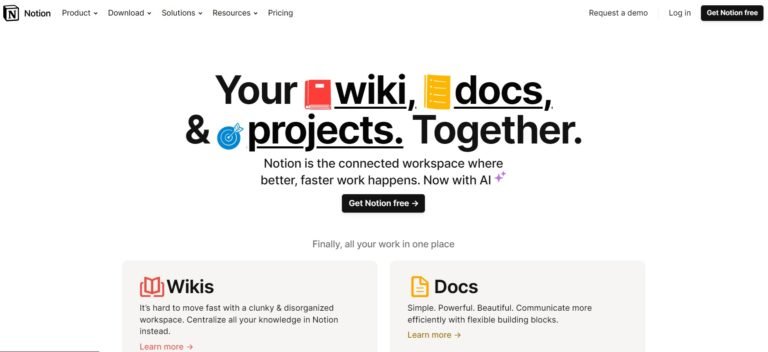
The Notion is a platform that combines the functions of a document editor, task manager, and database into a single workspace and note-taking tool. Users can create and organize different types of content, such as notes, documents, to-do lists, databases, wikis, and more, using the tool’s flexible and customizable interface. Notion users can build pages and subpages and add various content blocks, including text, images, tables, files, and embeds. It provides many templates and formatting options to organize and create content according to personal preferences.
Users can build complex information systems by linking pages, using filters and views, and building relational databases. Notion encourages collaboration by allowing real-time task assignments, editing, and commenting. Team members can collaborate on shared pages, provide feedback, and monitor progress. It also has integration capabilities, enabling users to connect and synchronize their workflows with other tools and services.
Features of Notion:
- A single workspace for task management, database creation, and note-taking.
- An interface that is adaptable and customizable with different content block choices.
- Real-time editing, commenting, and task assignment tools for collaboration.
- Possibilities for integration with other tools and services.
- Options for customizing Notion to fit unique workflows and needs.
Advantages of Notion:
- Versatile platform that unifies various functions in one location.
- Content organization and structuring options with customizable layout and formatting.
- Teamwork and real-time collaboration-supporting collaborative features.
- Having the ability to integrate with other tools and services.
- Options for customization to fit Notion to specific workflows.
Disadvantages of Notion:
- The learning curve for comprehending and using the entire feature set.
- Large and complex databases performing slowly or using a lot of integrations.
- Compared to the web version, the mobile app’s functionality is limited.
- Higher prices for groups or businesses with larger user bases.
- Periodic stability and synchronization issues that could degrade the user experience
3. Trello
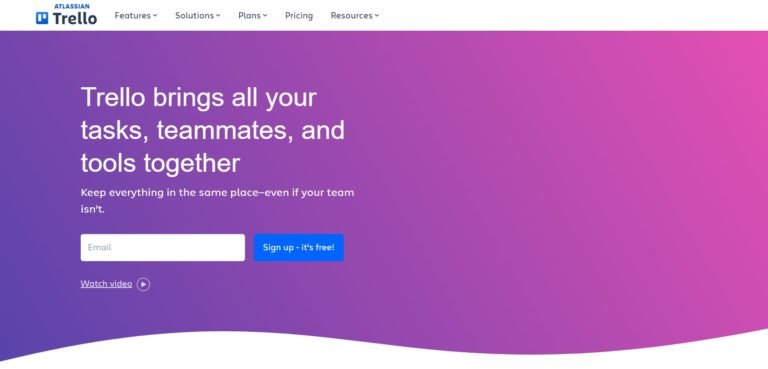
Trello is a web-based project management and digital planning tool that employs a visual user interface to assist individuals and teams in organizing tasks and projects. It is a popular option for individuals, small teams, and even large organizations due to its adaptability and simplicity of use.
It offers a flexible and user-friendly system built on boards, lists, and cards, enabling users to collaboratively create visual representations of their projects and track their progress. It can be used for team collaboration, agile workflows (like Scrum or Kanban), project management, and personal organization.
Features of Trello:
- Trello users can use boards, lists, and cards to organize and manage tasks and projects.
- The drag-and-drop interface makes it simple to move cards between lists and boards.
- Users can give each task labels and due dates to manage deadlines and categorize tasks.
- The ability to comment on cards and attach files makes collaboration easier.
- Users are informed of project updates and changes through notifications and an activity feed.
- Trello provides Power-Ups and connections to outside programs or services to increase its functionality.
- Mobile applications for iOS and Android enable access to Trello while on the go.
Advantages of Trello:
- Trello’s visual interface makes it simple to organize and comprehend how a project is progressing.
- It is simple to use and suitable for users of all experience levels.
- Collaborative features promote project teamwork and openness.
- Trello can be tailored to fit different project requirements and workflows.
- Users can access their boards from anywhere, thanks to their accessibility via web and mobile apps.
- Users can connect with other tools and services for better planning through integration options offered by Power-Ups.
Disadvantages of Trello:
- Trello’s reporting functions are restricted and lack sophisticated analytics and reporting features.
- Trello may make it difficult to manage projects with intricate workflows.
- It might lack more sophisticated task management features found in project management tools with a broader scope.
- Trello’s cloud-based architecture necessitates internet connectivity, which can be restrictive in cases of low or no connectivity.
4. Microsoft OneNote

Microsoft’s OneNote is a digital note-taking and organization tool. Users can capture, arrange, and share information across various devices. Users can format rich-text notes with different font styles, colors, and highlighting options. Whether you want to create and manage notes using text, images, web clippings, audio recordings, or even handwritten notes, OneNote offers a flexible and adaptable platform. It also allows the insertion of images, audio files, and video clips. Other Microsoft Office programs like Word, Excel, and PowerPoint are integrated with OneNote.
Users can quickly add content from these applications to their OneNote notes and link to them. With the ability to be tailored to individual preferences and work processes, Microsoft OneNote aims to offer a complete digital note-taking and organization solution.
Features of Microsoft OneNote:
- Creating notes with a variety of formatting options and support for multimedia.
- Arrangement with notebooks, sections, and pages for taking organized notes.
- Shared responsibility and cooperation for teamwork and group projects.
- Access notes from anywhere with device syncing.
- Microsoft Office integration for seamless content linking.
- Handwritten note input using digital ink and handwriting recognition.
Advantages of Microsoft OneNote:
- A versatile and adaptable platform for taking notes.
- Syncing with other Microsoft Office programs.
- Collaboration tools facilitate teamwork and note-sharing among teams.
- Device syncing ensures access to notes across various platforms.
- Support for natural note-taking with digital ink and handwriting recognition.
Disadvantages of Microsoft OneNote:
- Users’ learning curve when they’re not familiar with the features and interface.
- Some sophisticated features and capabilities might be overwhelming for simple note-taking requirements.
- limited organizational features in comparison to tools for project management with specialization.
- reliance on the Microsoft ecosystem for complete integration and compatibility.
- fewer formatting options than specific design software.
5. Monday.com

A well-liked web-based work operating system that assists teams in managing projects, tasks, and workflows is Monday.com, formerly known as Dapulse. Monday.com is renowned for its flexible interface and user-friendliness, enabling users to create boards, add tasks or items, designate team members, establish deadlines, and monitor project progress.
It offers a visual and adaptable platform where teams can collaborate, monitor progress, and maintain organization. Monday.com also facilitates collaboration by allowing team members to communicate with one another, post comments, attach files, and receive alerts. It supports integrations with well-known applications like Jira, Google Drive, and Slack to enable smooth workflow connections.
Features of Monday.com:
- Boards and columns that can be customized to organize tasks and projects.
- Kanban boards, Gantt charts, and timelines are examples of project-tracking visualizations.
- Features for collaboration, such as notifications, file attachments, and comments.
- options for seamless workflow connections with popular tools.
- Reporting and analytics to gain knowledge of the status of the project and the performance of the team.
Advantages of Monday.com:
- Adaptable workflow management and a user-friendly interface.
- Flexible visualizations for unambiguous project tracking and progress tracking.
- Team members who work well together and communicate effectively.
- Extensive tool integrations for streamlining workflows.
- Reporting and analytics capabilities for data-driven decision-making.
Disadvantages of Monday.com:
- Expenses may be high for little teams or organizations with tight budgets.
- The learning curve for comprehending and making use of all features
- Compared to specialized tools, lack of advanced automation capabilities
- For some use cases, there is limited customization flexibility.
- Team members unfamiliar with the platform might need more instruction or onboarding.
6. Evernote

Evernote is a well-known note-taking and information management tool that enables users to record, store, and access information across various devices. Evernote aspires to be a comprehensive platform for storing and accessing personal and professional information, acting as a productivity tool and digital filing system. It offers users a digital workspace to create, organize, and manage various types of content, such as text notes, web clippings, pictures, audio files, and files.
Features of Evernote:
- Note creation and organization with rich text editing capabilities
- Synchronization across multiple platforms for seamless device access
- Web clipping to store content, web pages, and images for later use
- Hierarchical organization and tagging for effective note retrieval
- Strong OCR search capabilities for finding specific information
- A team’s ability to collaborate and share features
- Integration with services and applications from third parties to improve functionality
Advantages of Evernote:
- A flexible and feature-rich note-taking program
- Synchronization between various devices for easy access
- Powerful search capabilities for quickly finding specific information
- Web clipping functionality for storing online content for later use
- Options for sharing and collaborating as a team
- Workflow improvement through integration with numerous third-party apps and services
Disadvantages of Evernote:
- There are restrictions on the number of devices and storage space in the free version.
- OCR precision varies, particularly for handwritten or intricate text in images.
- The free version has fewer advanced features like collaboration and offline access.
- Some users with significant needs might view the pricing structure as expensive.
7. Asana
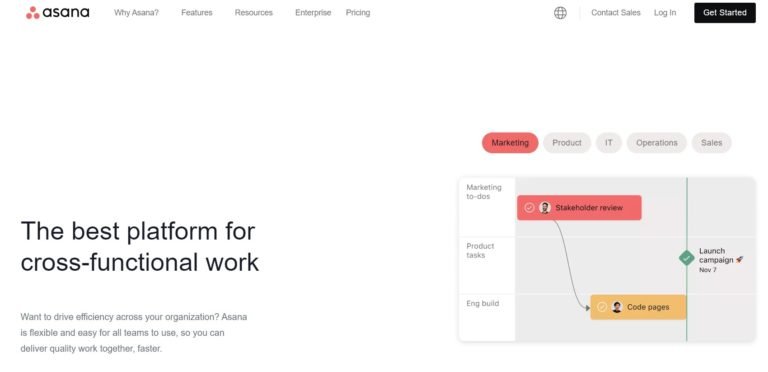
Asana is a web-based project management and collaboration tool that assists individuals and teams in effectively planning, monitoring, and managing their work. It offers a central location where tasks can be created, due dates set, roles assigned, and progress tracked for various projects and initiatives.
Asana has many features, including task management, team collaboration, project views, communication tools, integrations, and reporting options. It provides a complete solution for managing projects and tasks to streamline workflows, enhance productivity, and enhance team collaboration.
Features of Asana:
- Managing tasks with deadlines and grouping them into projects and sections
- Collaboration and dialogue via remarks, attachments, and mentions
- There are various project views, including a list, board, timeline, and calendar.
- Task dependencies and prioritization for effective workflow management
- Automation and integration with third-party applications and services
- Insights into project performance and progress through reporting and analytics
Advantages of Asana:
- Innovative task management and an easy-to-use interface
- Real-time communication and fluid teamwork
- Adaptable project views for various visual preferences
- Manage task dependency and prioritization effectively.
- Possibilities for integration and automation
- Analytical reporting and reporting in great detail for data-driven decision-making
Disadvantages of Asana:
- The learning curve for complex features and advanced functionalities
- Fewer customization possibilities than with some other tools
- Some users or organizations may find the pricing structure to be constraining.
8. Slack

Slack is a cloud-based collaboration platform that seeks to make teamwork and communication within organizations simpler and more efficient. Teams can communicate in a centralized, real-time setting to share files and integrate with other tools and services. Slack’s main objective is to replace conventional email communication and provide teams with more effective and organized communication and cooperation.
Features of Slack:
- Organized conversation and discussion channels
- Use direct messaging to communicate in confidence and detail.
- File collaboration and sharing across channels and direct messages
- Using apps to integrate workflow with other tools and services seamlessly
- Powerful search capabilities and notifications for quick information retrieval
- Voice and video calls for collaborative work and real-time communication
Advantages of Slack:
- Effective coordination of departmental and team communications
- Collaboration and real-time messaging promote speedy decision-making and problem-solving.
- Increased workflow productivity results from integration with a variety of tools and services.
- The search functionality makes it simple to find previous conversations and information.
- Voice and video calls enable remote collaboration and reduce the need for additional communication tools.
Disadvantages of Slack:
- This can result in information overload with too many notifications and messages.
- Users who are not familiar with chat-based communication platforms will face a steeper learning curve
- Larger teams or organizations may find the pricing structure to be expensive.
- Data privacy and security issues, especially about sensitive information
- Reliance on internet connectivity for file sharing and real-time communication
9. Todoist

Todoist is a well-known task management and to-do list app that helps keep people and teams productive and organized. Todoist integrates with well-known third-party services and apps, enabling users to link their task management with other applications. It offers a straightforward and user-friendly interface for managing tasks, assigning due dates, adding labels and priorities, and monitoring progress.
The goal of Todoist is to simplify task management while assisting users in effectively prioritizing and completing their to-do lists.Todoist seeks to make task management easier while assisting teams and individuals in maintaining organization, setting sensible priorities, and accomplishing their objectives. It offers a comprehensive task-capturing, management, and tracking approach that keeps users concentrated and productive.
Features of Todoist:
- Creation of tasks and division of tasks into projects and sections
- Due dates and notifications to help you finish tasks on time
- Task classification and identification labels, priorities, and filters
- Sharing and cooperating for effective teamwork
- Automating features and integration with third-party apps
- Sync tasks between devices for accessibility anywhere.
Advantages of Todoist:
- Easy task management with a straightforward and intuitive interface
- Synchronization across platforms allows users to access tasks from various devices
- Collaboration tools make teamwork and coordination easier
- Integration with other applications improves output and workflow effectiveness.
- The personalized organization with editable labels, priorities, and filters
Disadvantages of Todoist:
- The free version has fewer advanced features like task reminders and collaboration.
- Some features might need a premium subscription to function fully.
- The learning curve for comprehending and using all features offered
- Fewer options for visualization and reporting than with specialized project management tools
- Internet connectivity is required for real-time synchronization and updates.
10. Airtable
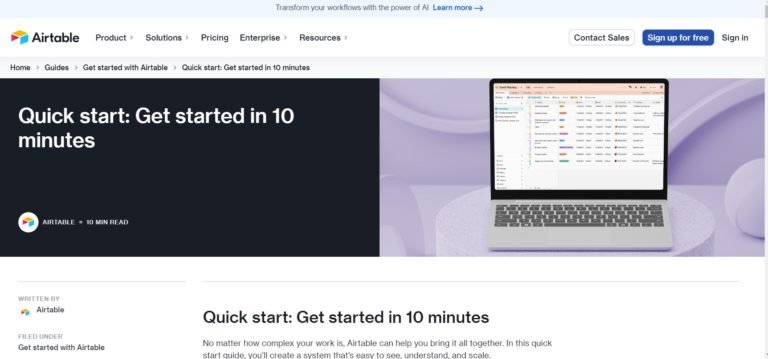
A collaborative platform called Airtable combines the features of a database and a spreadsheet in the cloud. It offers a versatile and aesthetically pleasing interface for managing and organizing data. It is a well-liked option for groups and individuals looking for a more flexible and organized way to track and analyze data.
Features of Airtable:
- Adaptable database design and customizable fields
- A spreadsheet-like visual grid interface
- Multiple views to accommodate different needs for data visualization
- Tools for instantaneous teamwork that promote collaboration and sharing
- Increasing workflow effectiveness by integrating it with other programs and services
- Advanced options for grouping, sorting, and filtering data
Advantages of Airtable:
- Versatile platform for data management and organization
- Drag-and-drop functionality and an intuitive interface
- Adaptable fields and views for specialized needs
- Real-time collaboration improves productivity and teamwork
- Functionality is expanded through integration with widely used apps and services.
- Flexible data organization is possible thanks to sophisticated filtering and sorting options.
Disadvantages of Airtable:
- Users who are not familiar with databases or spreadsheets will have a steeper learning curve
- Fewer sophisticated features than more specialized database management systems
- The pricing structure might be expensive for larger teams or more challenging projects.
- Limited automation abilities in comparison to workflow automation tools, specifically
- Reliance on internet connectivity for real-time data access and collaboration
FAQ - Digital Planning Tools & Apps 2023
What are some well-liked apps and tools for digital planning?
What benefits do digital planning tools offer?
Can I use these digital planning tools for both personal and work-related purposes?
Can these tools be synced between different devices?
Do these digital planning tools have free versions available?
Conclusion - Digital Planning Tools
Keeping organized and handling tasks well are crucial in today’s digitally-driven world. The availability of numerous digital planning tools and apps has completely changed how we collaborate, plan, and remain productive. These 10 digital planning tools offer a variety of features and benefits to suit your needs, whether you’re an individual looking to streamline your tasks or a team looking for effective project management.
Each tool has its distinct advantages, from the user-friendly task boards of Trello to the simple scheduling of Google Calendar, from the flexible note-taking of Evernote to the collaborative platform of Monday.com. When choosing a digital planning tool, it’s important to think about your specific needs and personal preferences. Utilize the power of technology to your advantage and maximize your productivity with these outstanding digital planning tools and apps.